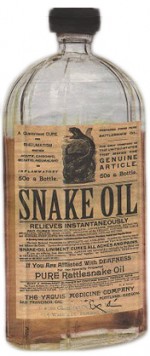 We use the term “snake oil” for anything promoted as a cure-all that doesn’t work, whether it is medicine or political policy. But back in the 1860s, Chinese immigrants who worked on the Transcontinental Railroad used oil from the Chinese water snake to treat sore muscles, and it worked!
We use the term “snake oil” for anything promoted as a cure-all that doesn’t work, whether it is medicine or political policy. But back in the 1860s, Chinese immigrants who worked on the Transcontinental Railroad used oil from the Chinese water snake to treat sore muscles, and it worked!
A 2007 story in Scientific American explains that California neurophysiology researcher Richard Kunin made the connection between Chinese water snakes and omega-3 fatty acids in the 1980s.
“Kunin visited San Francisco’s Chinatown to buy such snake oil and analyze it. According to his 1989 analysis published in the Western Journal of Medicine, Chinese water-snake oil contains 20 percent eicosapentaenoic acid (EPA), one of the two types of omega-3 fatty acids most readily used by our bodies. Salmon, one of the most popular food sources of omega-3s, contains a maximum of 18 percent EPA, lower than that of snake oil.”
However, it wasn’t until several years after Kunin’s research that American scientists discovered that omega-3s are vital for human metabolism. Not only do they sooth inflammation in muscles and joints, but also, they can help “cognitive function and reduce blood pressure, cholesterol, and even depression.”
So how did “snake oil” come to mean a scam? The rest of the story is at Collectors Weekly. Link -Thanks, Ben!
Read the article:
How Snake Oil Got a Bad Rap




